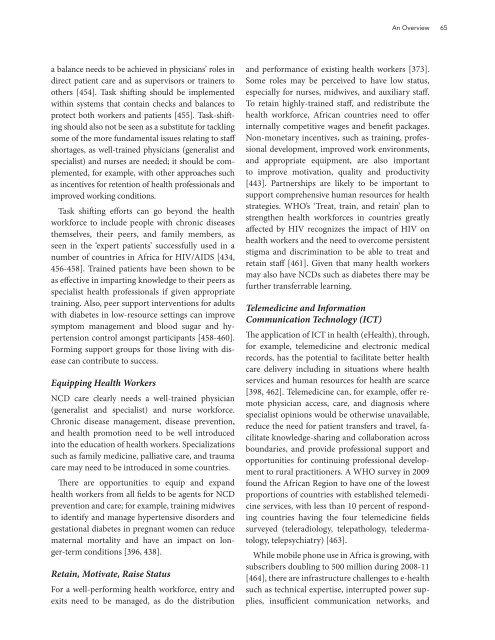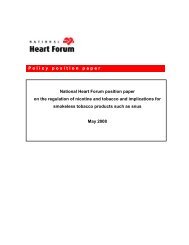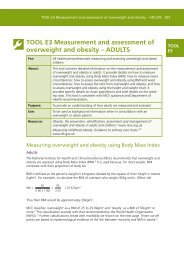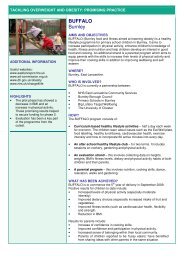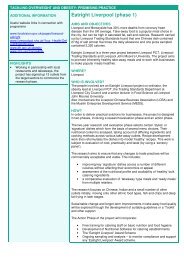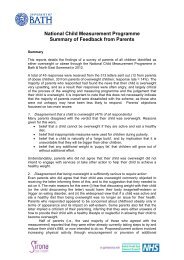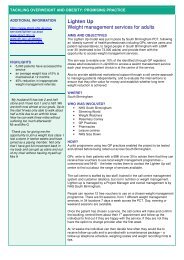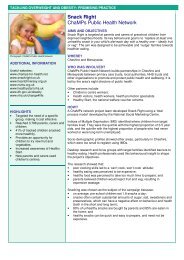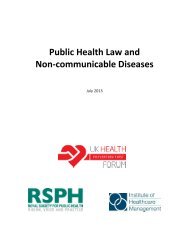The Challenge of Non-Communicable Diseases and Road Traffic ...
The Challenge of Non-Communicable Diseases and Road Traffic ...
The Challenge of Non-Communicable Diseases and Road Traffic ...
Create successful ePaper yourself
Turn your PDF publications into a flip-book with our unique Google optimized e-Paper software.
An Overview 65<br />
a balance needs to be achieved in physicians’ roles in<br />
direct patient care <strong>and</strong> as supervisors or trainers to<br />
others [454]. Task shifting should be implemented<br />
within systems that contain checks <strong>and</strong> balances to<br />
protect both workers <strong>and</strong> patients [455]. Task-shifting<br />
should also not be seen as a substitute for tackling<br />
some <strong>of</strong> the more fundamental issues relating to staff<br />
shortages, as well-trained physicians (generalist <strong>and</strong><br />
specialist) <strong>and</strong> nurses are needed; it should be complemented,<br />
for example, with other approaches such<br />
as incentives for retention <strong>of</strong> health pr<strong>of</strong>essionals <strong>and</strong><br />
improved working conditions.<br />
Task shifting efforts can go beyond the health<br />
workforce to include people with chronic diseases<br />
themselves, their peers, <strong>and</strong> family members, as<br />
seen in the ‘expert patients’ successfully used in a<br />
number <strong>of</strong> countries in Africa for HIV/AIDS [434,<br />
456-458]. Trained patients have been shown to be<br />
as effective in imparting knowledge to their peers as<br />
specialist health pr<strong>of</strong>essionals if given appropriate<br />
training. Also, peer support interventions for adults<br />
with diabetes in low-resource settings can improve<br />
symptom management <strong>and</strong> blood sugar <strong>and</strong> hypertension<br />
control amongst participants [458-460].<br />
Forming support groups for those living with disease<br />
can contribute to success.<br />
Equipping Health Workers<br />
NCD care clearly needs a well-trained physician<br />
(generalist <strong>and</strong> specialist) <strong>and</strong> nurse workforce.<br />
Chronic disease management, disease prevention,<br />
<strong>and</strong> health promotion need to be well introduced<br />
into the education <strong>of</strong> health workers. Specializations<br />
such as family medicine, palliative care, <strong>and</strong> trauma<br />
care may need to be introduced in some countries.<br />
<strong>The</strong>re are opportunities to equip <strong>and</strong> exp<strong>and</strong><br />
health workers from all fields to be agents for NCD<br />
prevention <strong>and</strong> care; for example, training midwives<br />
to identify <strong>and</strong> manage hypertensive disorders <strong>and</strong><br />
gestational diabetes in pregnant women can reduce<br />
maternal mortality <strong>and</strong> have an impact on longer-term<br />
conditions [396, 438].<br />
Retain, Motivate, Raise Status<br />
For a well-performing health workforce, entry <strong>and</strong><br />
exits need to be managed, as do the distribution<br />
<strong>and</strong> performance <strong>of</strong> existing health workers [373].<br />
Some roles may be perceived to have low status,<br />
especially for nurses, midwives, <strong>and</strong> auxiliary staff.<br />
To retain highly-trained staff, <strong>and</strong> redistribute the<br />
health workforce, African countries need to <strong>of</strong>fer<br />
internally competitive wages <strong>and</strong> benefit packages.<br />
<strong>Non</strong>-monetary incentives, such as training, pr<strong>of</strong>essional<br />
development, improved work environments,<br />
<strong>and</strong> appropriate equipment, are also important<br />
to improve motivation, quality <strong>and</strong> productivity<br />
[443]. Partnerships are likely to be important to<br />
support comprehensive human resources for health<br />
strategies. WHO’s ‘Treat, train, <strong>and</strong> retain’ plan to<br />
strengthen health workforces in countries greatly<br />
affected by HIV recognizes the impact <strong>of</strong> HIV on<br />
health workers <strong>and</strong> the need to overcome persistent<br />
stigma <strong>and</strong> discrimination to be able to treat <strong>and</strong><br />
retain staff [461]. Given that many health workers<br />
may also have NCDs such as diabetes there may be<br />
further transferrable learning.<br />
Telemedicine <strong>and</strong> Information<br />
Communication Technology (ICT)<br />
<strong>The</strong> application <strong>of</strong> ICT in health (eHealth), through,<br />
for example, telemedicine <strong>and</strong> electronic medical<br />
records, has the potential to facilitate better health<br />
care delivery including in situations where health<br />
services <strong>and</strong> human resources for health are scarce<br />
[398, 462]. Telemedicine can, for example, <strong>of</strong>fer remote<br />
physician access, care, <strong>and</strong> diagnosis where<br />
specialist opinions would be otherwise unavailable,<br />
reduce the need for patient transfers <strong>and</strong> travel, facilitate<br />
knowledge-sharing <strong>and</strong> collaboration across<br />
boundaries, <strong>and</strong> provide pr<strong>of</strong>essional support <strong>and</strong><br />
opportunities for continuing pr<strong>of</strong>essional development<br />
to rural practitioners. A WHO survey in 2009<br />
found the African Region to have one <strong>of</strong> the lowest<br />
proportions <strong>of</strong> countries with established telemedicine<br />
services, with less than 10 percent <strong>of</strong> responding<br />
countries having the four telemedicine fields<br />
surveyed (teleradiology, telepathology, teledermatology,<br />
telepsychiatry) [463].<br />
While mobile phone use in Africa is growing, with<br />
subscribers doubling to 500 million during 2008-11<br />
[464], there are infrastructure challenges to e-health<br />
such as technical expertise, interrupted power supplies,<br />
insufficient communication networks, <strong>and</strong>


